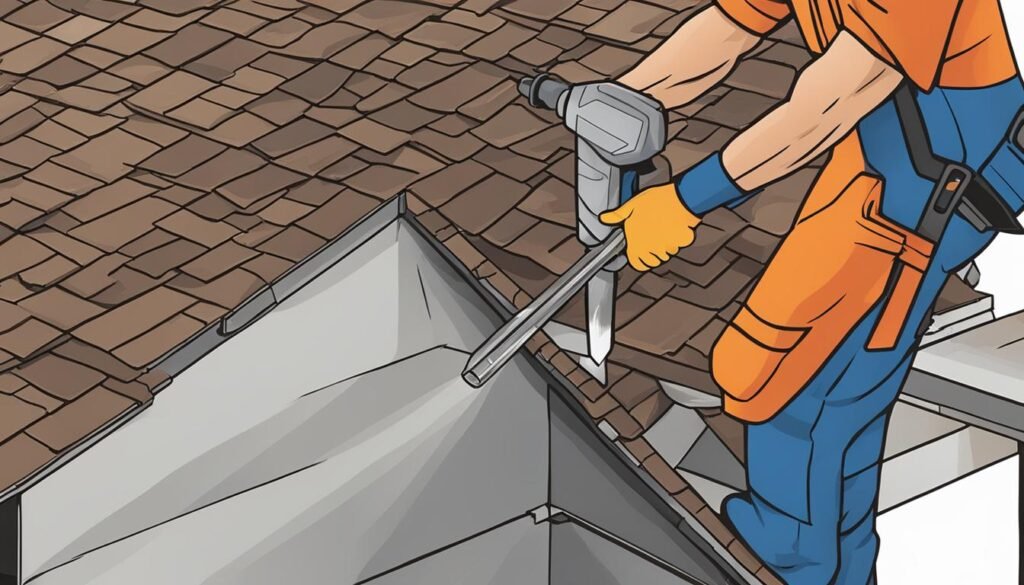Roof jacks are an essential tool used in the roofing industry. They serve the purpose of sealing open vents on roofs, also known as roof flashing. It’s important to understand their usage and benefits to ensure proper installation and maintenance. They prevent hazardous weather such as rain, snow, sleet, and debris from entering the plumbing vent pipes. Roof jacks work in conjunction with vent caps to keep the pipes dry and clear of obstructions. Installing roof jacks requires climbing onto the roof and securely attaching them under the shingles. It is recommended to hire a professional roofing contractor for this task to ensure safety and longevity.
Key Takeaways:
- Roof jacks are used to seal open vents on roofs, preventing the entry of rain, snow, and debris.
- They work in conjunction with vent caps to keep plumbing vent pipes dry and clear of obstructions.
- Professional installation is recommended to ensure safety and longevity of roof jacks.
- Roof jacks are an essential tool in the roofing industry.
- Understanding their purpose and usage is crucial for proper installation and maintenance.
Types of Roof Jacks for Different Roofing Needs
When it comes to roofing projects, choosing the right type of roof jack is essential for ensuring a successful installation. Different roof jacks are designed to meet specific roofing needs, providing the necessary protection and stability for different types of roofs. Understanding the various types of roof jacks available can help homeowners and roofing professionals make informed decisions and achieve optimal results.
One common type of roof jack is the pipe jack, which is specifically used to seal vent pipes on roofs and prevent water and debris from entering. Pipe jacks are available in different materials, including rubber neoprene and metal. While rubber neoprene pipe jacks are popular due to their affordability, they have a shorter lifespan compared to their metal counterparts. Metal roof jacks, on the other hand, offer superior durability and can withstand the elements for a longer period.
Aside from pipe jacks, there are also flat roof jacks and ladder roof jacks. Flat roof jacks provide a stable surface for working on flat roofs, ensuring the safety of workers and preventing any accidents. Ladder roof jacks, on the other hand, are designed to assist in accessing higher areas of the roof, providing a secure platform for maintenance and repair tasks.
Different Types of Roof Jacks:
- Pipe Jacks
- Flat Roof Jacks
- Ladder Roof Jacks
By understanding the different types of roof jacks available, homeowners and roofing professionals can select the most suitable option based on the specific roofing needs and requirements of each project.
Installing and Replacing Roof Jacks: Step-by-Step Guide
Proper installation and replacement of roof jacks is essential in maintaining the integrity and functionality of your roofing system. Whether you are installing new roof jacks or replacing old ones, following a step-by-step guide will ensure a successful and long-lasting outcome.
Gather the necessary tools and ensure roof safety
Before starting the installation or replacement process, it is crucial to gather all the necessary tools, including a ladder, a knife, and new roof jacks. Additionally, make sure to prioritize your safety by wearing appropriate protective gear and taking necessary precautions when working on the roof.
Lift the shingles and remove the old roof jack
Begin by lifting the shingles surrounding the vent pipe where the roof jack will be installed or replaced. Use a knife to gently lift the edges of the shingles, being careful not to damage them. Once the shingles are lifted, remove the old roof jack, including any nails securing it in place.
Slide the new roof jack over the vent pipe and secure it
Slide the new roof jack over the vent pipe, ensuring it fits snugly. Position it in the same location as the previous roof jack. Secure the new roof jack in place by hammering nails through the designated holes, making sure they are driven firmly into the roof. This will prevent any movement or potential leaks.

Replace and secure the shingles
Once the new roof jack is securely fastened, carefully place the lifted shingles back into position. Ensure they are aligned correctly and cover the roof jack completely. Use roofing nails to secure the shingles in place, ensuring a tight and watertight seal.
By following these step-by-step instructions, you can confidently install or replace roof jacks and maintain the integrity of your roofing system.
Maintaining Roof Jacks for Longevity
Proper maintenance is essential for ensuring the longevity and functionality of roof jacks. By regularly inspecting the roof jacks, you can identify any signs of damage, such as rust or loose nails, and address them promptly. This proactive approach will help prevent potential water leakage and deterioration of the roof over time.
During maintenance, pay close attention to the sealing of nails and shingles. The proper installation and replacement of roof jacks require secure sealing to maintain the integrity of the roof and prevent any potential leaks. By ensuring a tight seal, you can safeguard your roof and prolong the lifespan of the roof jacks.
Keeping your roof clean and free from debris is another vital aspect of roof jack maintenance. Regularly removing leaves, branches, and other obstructions from your roof will help prevent clogs and damage to the roof jacks. Additionally, a clean roof minimizes the risk of water pooling and the growth of mold or mildew.
Regular inspections and timely maintenance of your roof jacks will go a long way in preserving the integrity of your roof and maximizing their lifespan. By taking these proactive measures, you can avoid costly repairs and ensure that your roof remains in excellent condition for years to come.
The Importance of Professional Roofing Services for Roof Jack-related Tasks
When it comes to roof jack installation, replacement, and maintenance, seeking the expertise of professional roofing services is crucial. These professionals possess the knowledge and experience to handle these tasks efficiently and safely, ensuring optimal performance and longevity of your roof jacks.
Professional roofers understand the proper techniques for installing roof jacks, using high-quality materials that adhere to industry standards. By entrusting this task to the professionals, you can have peace of mind knowing that the installation is done correctly, minimizing the risk of leaks or other issues in the future.
Additionally, professional roofing services offer comprehensive inspections that go beyond just roof jacks. They can identify any underlying issues that may impact the overall health of your roof, providing appropriate solutions to address them. By addressing these issues early on, you can avoid costly repairs down the line.
Investing in professional roofing services also saves you time and effort. Instead of attempting to install or replace roof jacks yourself, which can be a complex task, you can rely on the expertise of professionals who can complete the job efficiently and effectively. Their knowledge and experience in roof jack maintenance ensure that your roof jacks remain in optimal condition, contributing to the longevity of your roof.
FAQ
What is a roof jack?
A roof jack is an essential tool used in the roofing industry to seal open vents on roofs, also known as roof flashing.
What is the purpose of a roof jack?
The purpose of a roof jack is to prevent hazardous weather such as rain, snow, sleet, and debris from entering the plumbing vent pipes on the roof.
How do roof jacks work?
Roof jacks work in conjunction with vent caps to keep the pipes dry and clear of obstructions, allowing proper ventilation while preventing water and debris from entering.
What types of roof jacks are available?
There are various types of roof jacks available, including pipe jacks, rubber neoprene pipe jacks, metal roof jacks, flat roof jacks, and ladder roof jacks.
How do I install and replace roof jacks?
The installation process involves climbing onto the roof, securely attaching the roof jacks under the shingles, and ensuring proper sealing of the nails and shingles. The replacement process follows a similar step-by-step guide, with extra care taken to remove and replace the damaged or worn-out roof jack.
How do I maintain roof jacks?
Regular maintenance of roof jacks is important to ensure their longevity and functionality. Periodic inspections for any signs of damage, such as rust or loose nails, should be conducted. Damaged or worn-out roof jacks should be promptly replaced, and the roof should be kept clean and free from debris.
Why should I hire professional roofing services for roof jack-related tasks?
Professional roofers have the expertise and experience to handle roof jack-related tasks safely and efficiently. They understand proper installation techniques, use high-quality materials, and can provide comprehensive inspections and solutions for maintaining the overall health of the roof.

